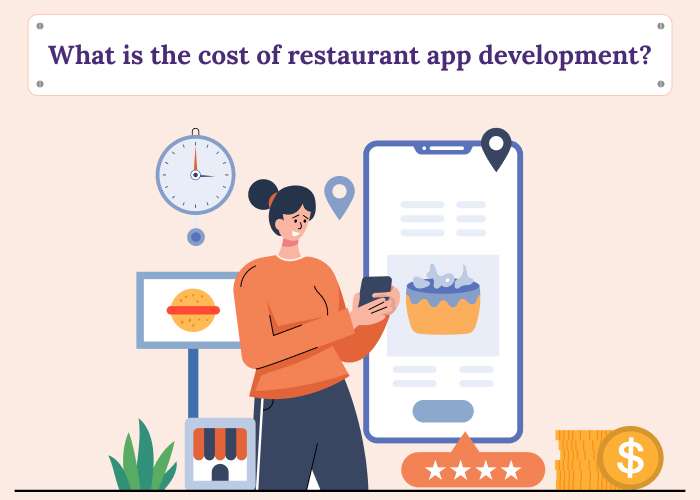Why Should You Develop a Restaurant Application?
- Customers may easily and conveniently browse menus, place orders, make bookings, and leave reviews with the help of a well-designed restaurant app. Increased client satisfaction and loyalty may result from this simplified experience.
- Restaurants may expand their client base and draw in new ones by being present on mobile platforms, especially for those who enjoy using apps for dining-related purposes.
- Restaurant applications may automate a number of processes, including payment processing, table bookings, and order management, which helps expedite operations and cut down on human error. Better resource use and cost reductions may result from this efficiency.
What is the cost of restaurant app development?

The price of basic restaurant app development with few features ranges between $8000 and $15,000. Conversely, an extensive restaurant app that includes features like GPS order tracking, restaurant pre-ordering, etc. begins from $25,000.
It’s advisable for businesses to create an MVP before delving into the creation of restaurant applications. A functional prototype of your app concept is usually a good idea before investing in full-fledged restaurant app development. In this manner, you may observe how users are responding to the application and what features, modifications, and upgrades they would want to see.
Features to add while restaurant app development
There are a few things you may think about when creating a restaurant app in order to improve user experience. The following are some features that you might include:
- User Registration/Login: Allow users to create accounts or log in using social media accounts to personalize their experience and enable features like order history and saved preferences.
- Menu with Images and Descriptions: Display a visually appealing menu with detailed descriptions, prices, and images of dishes to help users make informed decisions.
- Search and Filter: Implement search and filter options to help users easily find specific dishes, cuisines, dietary preferences, or price ranges.
- Ordering and Reservations: Enable users to place orders for delivery, pickup, or dine-in directly through the app. Additionally, allows users to make table reservations for dine-in.
- Real-time Order Tracking: Provide users with real-time updates on the status of their orders, including preparation, dispatch, and estimated delivery/pickup time.
- Payment Gateway Integration: Integrate secure payment gateways to facilitate seamless online payments, including credit/debit cards, digital wallets, and mobile payment options.
- Rating and Reviews: Allow users to rate dishes, leave reviews, and provide feedback on their dining experience to help improve the quality of service.
- Push Notifications: Send timely notifications to users about order status updates, special offers, promotions, and discounts to keep them engaged.
- Loyalty Program: Implement a loyalty program that rewards users for frequent orders or visits with discounts, coupons, or other incentives.
- Table Reservation Management: Provide restaurant staff with a dashboard to manage table reservations efficiently, including confirming, modifying, or canceling reservations.
- Admin Dashboard: Develop an admin dashboard to manage menu items, update prices, monitor orders, analyze sales data, and oversee overall app performance.
Conclusion
For restaurant operators, creating an application for their establishment may be a profitable investment that yields several advantages including enhanced customer satisfaction, a larger clientele, and improved operational efficiency.
However, the features and complexity of the application determine how much it will cost to design a restaurant app. While more complex apps with sophisticated features might start at $approx. 25,000, basic restaurant apps might cost between $8000 and $15,000 approximately.
Before investing in full-scale development, firms can think about creating a minimal viable product (MVP) to test the concept of the app and get feedback from users.
Restaurant operators may improve the user experience and increase client engagement by adding necessary features including user registration, menu browsing, ordering, real-time tracking, payment integration, and loyalty programs.
FAQs
Can a restaurant app help attract more customers?
How long does it take to develop a restaurant app?
What measures can I take to ensure the security of online payments in my restaurant app?
How can I gather feedback from users to improve my restaurant app?
Are there any ongoing maintenance costs associated with running a restaurant app?
Ravi Bhojani is the Chief Marketing Officer (CMO) at Alian Software, where he spearheads the company’s marketing strategies and drives its brand presence in the competitive IT services landscape. With over a decade of experience in the technology and marketing sectors, Ravi has consistently demonstrated his ability to blend innovative marketing techniques with deep industry knowledge to deliver outstanding results.